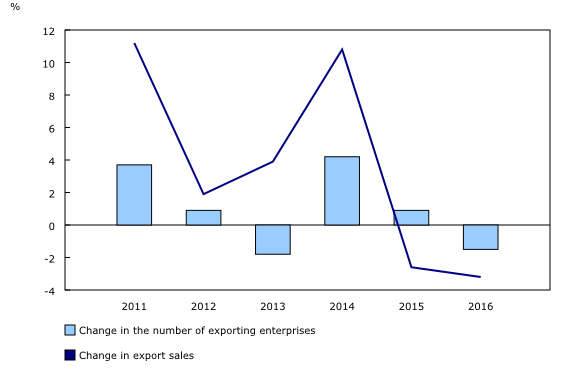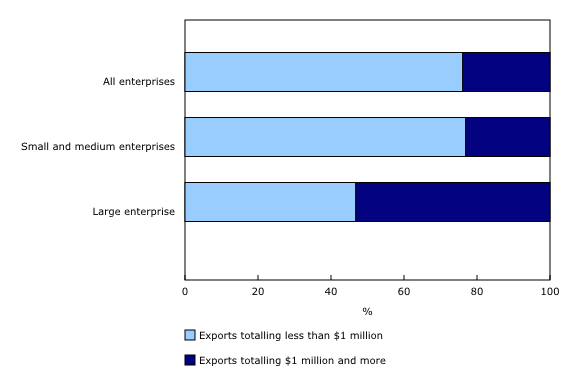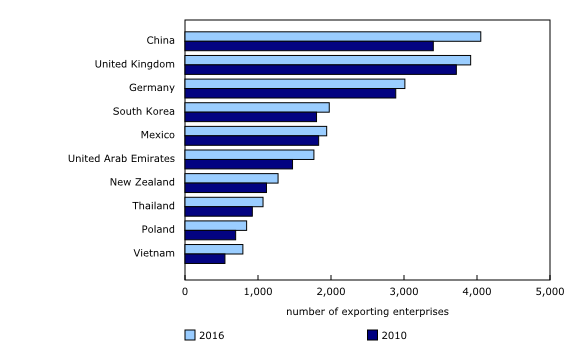Trade by exporter characteristics: Goods, 2016
Archived Content
Information identified as archived is provided for reference, research or recordkeeping purposes. It is not subject to the Government of Canada Web Standards and has not been altered or updated since it was archived. Please "contact us" to request a format other than those available.
Released: 2017-05-02
There were 43,255 exporting enterprises of goods in Canada in 2016, with export sales totalling $442.2 billion. The number of exporting enterprises was down for the first time since 2013, while lower energy prices drove down export sales for the second straight year.
The number of exporting enterprises was down by 1.5% in 2016, with small and medium enterprises (SMEs) accounting for the bulk of the decline. There were 616 fewer exporting SMEs in 2016 than 2015, with most of the enterprises trading goods solely with the United States. Nonetheless, SMEs accounted for 97.4% of all exporting enterprises in 2016, a share that has remained stable since 2010.
Most exporting enterprises export less than $1 million of goods annually
Export sales declined by $14.7 billion or 3.2% in 2016. The decrease was mainly attributable to large enterprises. Although large enterprises represented less than 3% of all exporters in Canada in 2016, they were responsible for almost 60% of all export sales.
Exports remained highly concentrated in 2016. The top 20 exporters accounted for nearly one-third of all sales. The largest 500 exporters in Canada, representing about 1% of all exporters, were responsible for over three-quarters of total export sales.
Consequently, the vast majority of exporters tended to have relatively low export sales. Enterprises exporting goods for less than $1 million in total during 2016 accounted for over three-quarters (32,919) of all exporting enterprises in the country. Since 2010, over three-quarters of all SMEs and almost half of all large enterprises have consistently exported less than $1 million worth of goods annually.
Export activity continues to expand with China
While the US dominates, China remained Canada's second most important exporting partner in 2016, both in terms of number of exporting enterprises and export sales. In 2016, 35,203 enterprises exported $341.3 billion worth of goods to the United States. At the same time, 4,052 firms exported goods to China in 2016, totalling $19.4 billion. The number of exporting enterprises and export sales to the United States both fell in 2016 compared with 2015, while both were up for China.
From 2010 to 2016, the number of exporting enterprises in Canada increased by 2,644, largely due to more enterprises exporting to the United States. In all, there were 2,230 more enterprises exporting to the United States in 2016 than in 2010. Other notable increases during this period were in the number of enterprises exporting to China (+651), United Arab Emirates (+293) and Vietnam (+246).
Lower exporting activity in most provinces
Exporter characteristics can also be analyzed based on establishments in addition to enterprises. The establishment, the smallest statistical unit within an enterprise structure, better reflects the primary industrial activity and the province of the exporter. One enterprise can have multiple establishments operating in different provinces and industries.
On this basis, there were 48,343 exporting establishments in Canada in 2016, down 1.5% from 2015. There were fewer exporters in every province except Quebec, Prince Edward Island and Nova Scotia. The largest declines were in Alberta (-289), followed by Ontario (-276) and Manitoba (-234).
Export sales were also down in most provinces, notably in Alberta where they fell 17.1%. British Columbia was one of the few provinces to show an increase. Export sales generated by establishments in British Columbia grew by 14.5% in 2016, on the strength of the manufacturing and wholesale trade sectors.
The share of the manufacturing sector in Canada's export sales increases
On an industry basis, establishments in the manufacturing sector accounted for more than one-third of all exporting establishments in Canada while generating two-thirds of all export sales in 2016. This was the highest share of export sales since data became available.
On the other hand, the mining, quarrying and oil and gas extraction industry was responsible for just over 1% of all exporting establishments, but more than 10.6% ($46.8 billion) of all export sales in 2016. This proportion has been declining in recent years, from a high of 18.2% ($72.8 billion) of total export sales in 2011. From 2011 to 2016, export energy prices decreased by 35.6%.
Export sales in the mining, quarrying and oil and gas extraction industry in Canada were down by 23.0% in 2016, following an 11.8% decrease in 2015. At the same time, the number of exporting establishments in this industry was down by 10.1% in 2016. Alberta contributed the most to the slowdown in exporting activity in this industry.
Note to readers
The Trade by Exporter Characteristics (TEC): Goods program is an initiative at Statistics Canada undertaken to analyze the business characteristics of exporters in Canada. These estimates are formed by linking customs trade data records to business entities in Statistics Canada's Business Register.
Data on exports to the United States are collected by the US Census Bureau and transmitted to Statistics Canada as part of the Canada–US data exchange, while data on exports to the rest of the world are collected jointly by Statistics Canada and the Canada Border Services Agency.
The Business Register contains the complete operating and legal structure of enterprises operating in Canada, as well as their key characteristics such as employment and North American Industry Classification System code.
Survey definitions
This release contains information at both the enterprise and establishment levels. An enterprise is defined as the statistical unit that directs and controls the allocation of resources relating to its domestic operations, and for which consolidated financial statements are maintained. An establishment is defined as the statistical unit where the accounting data required to measure production are available. The two measures generate a different number of exporting units as well as a different industry allocation of these units.
Small and medium-sized enterprises have fewer than 500 employees, including those that did not report any employment. Large enterprises have 500 or more employees.
Detailed information on concepts and methodology relating to this release is available on the TEC: Goods program survey page (5124).
Survey coverage
In this release, the total value of exports refers to the part of the annual domestic export value (customs basis) that can be linked to specific entities in the Business Register each year. Annual domestic export values (customs basis) can be obtained from CANSIM table 228-0060. Additional information and definitions related to domestic merchandise exports are available on the survey page for Canadian International Merchandise Trade (Customs Basis) (2201).
Each year from 2010 to 2016, the total number of identified exporting enterprises accounted for 96% to 98% of the total domestic export value. Throughout this release, the percentage share of export sales corresponds to the share of the annual domestic export value for which there was an identified exporter. The number of exporters corresponds to the number of exporters identified within the Business Register by the TEC: Goods program.
Products
The Methodological Guide: Canadian System of Macroeconomic Accounts (13-607-X) is available.
The User Guide: Canadian System of Macroeconomic Accounts (13-606-G) is also available. This publication will be regularly updated to maintain its relevance.
Contact information
For more information, contact us (toll-free 1-800-263-1136; 514-283-8300; STATCAN.infostats-infostats.STATCAN@canada.ca).
To enquire about the concepts, methods or data quality of this release, contact Angela Yuan-Wu (613-240-2871; angela.yuanwu@canada.ca) or Ying Di (613-867-2736; ying.di@canada.ca), International Accounts and Trade Division.
- Date modified:




